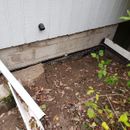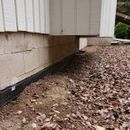Grading Around Exterior of Waterproofed Foundation
We just had our foundation waterproofed on the exterior of our 40 year old house in central Ontario (excavated to footings, Bakor Aqua-Bloc liquid-applied sealant, Armtec Platon dimple mat, weeping tile replaced, drain fed to sump pump). Climate Zone 6, but in a snow-belt where we often have 2-3 feet of snow on the ground for months at a time.
The contractors removed a bunch of large rocks from around the foundation and because of that did not have sufficient fill to properly grade away from the house. They tried to get away with it by not compacting the upper layers of soil, but as soon as it rained, the soil compacted and created a negative grade in some areas (grading towards the house, as shown in first picture). I know this is unacceptable and understand how much of a grade I need. What I’m concerned with is three things:
1. How high can the soil fill go above the top of the dimple board? Right now the soil hits about 1-2 inches below the top of the dimple board. If I add 5 or 6 inches, bringing the grade 4-5 inches above the dimple mat (on a cinderblock wall), am I compromising the waterproofing?
2. The contractor is suggesting that they could use some triple mix that we already have on site to grade. It would form the top 3 to 10 inches, depending on which part of the house we’re looking at. My understanding was that triple mix is not ideal here, since it’s high in organic content and we want a soil with less organic and more clay content. Is it worth trying to source and buy a special type of fill for this, or should I just let them use triple mix? We do not plan to plant anything around the foundation and want to do this job right.
3. The contractors said we should have the cinderblock foundation above the dimple mat parged. Is this necessary and/or a good idea? I understand that parging doesn’t last long in our climate (see above) and don’t want to do something high-maintenance if it’s not solving any problems. We’ve only seen water seepage at the base of the wall. There are some very small hairline cracks in the mortar and one cracked block, shown in the second picture.
Any advice is much appreciated. Thanks in advance.
GBA Detail Library
A collection of one thousand construction details organized by climate and house part











Replies
What is the native/fill soil like, and is there anyway to move that for grading? Or are you on fairly level terrain?
When filling above your dimple board, just be sure the top of the dimple board is well sealed to the wall so soil doesn't get behind the fabric (it is a fabric type, yes?).
It's hard to answer #2 but triple mix certainly doesn't sound ideal. It might depend a bit on whether you are on the eave side and if you have gutters (appears you do). The ground by the gable wall has a much smaller water shed than the eave wall (even with gutters, assuming they occasionally clog).
#3, You could consider just painting a waterproof coating on. Any coating or parging would protect against slash back, so it's helpful but not usually critical for most situations.
Thanks, Tyler -- very much appreciated on all fronts! The native soil is well-draining but not sandy, not particularly high clay content, but it would be better than the triple mix for sure. I'll try digging some up from a remote area of the yard and see how that goes. The dimple board is a hard plastic board and it's sealed against the concrete with some thick black specialized caulk and a sealing strip that the manufacturer supplies with the dimple board. It looks pretty impervious to me.